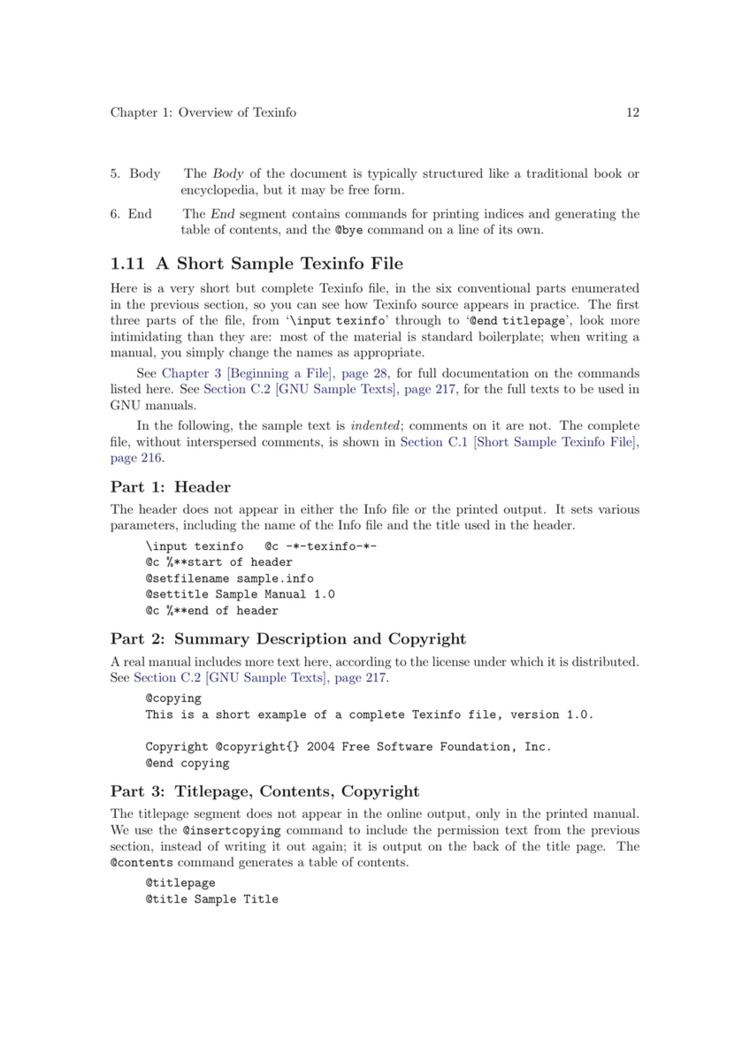Developer(s) Brian FoxKarl Berry Development status active | Initial release February 1986 | |
 | ||
Original author(s) Stable release 6.1 (February 6, 2016; 13 months ago (2016-02-06)) [±] | ||
Texinfo is a typesetting syntax used for generating documentation in both on-line and printed form (creating filetypes as dvi, html, pdf, etc., and its own hypertext format, info) with a single source file. It is implemented by a computer program released as free software of the same name, created and made available by the GNU Project from the Free Software Foundation.
Contents
The main purpose of Texinfo is to provide a way to easily typeset software manuals. Similar to the LaTeX syntax, all the normal features of a book, such as chapters, sections, cross references, tables and indices are available for use in documents. Using the various output generators that are available for Texinfo, it is possible to keep several documentation types up-to-date (such as on-line documentation provided via a Web site, and printed documentation, as generated using the TeX typesetting system) using only a single source file.
The official Texinfo documentation states that the first syllable of "Texinfo" is pronounced so as to rhyme with "speck", not "hex"; this pronunciation is derived from the pronunciation of TeX, in which the X represents the Greek letter "chi" rather than the English letter "ex". The maintainers state that "Texinfo" should be written with only a capital "T" and the rest of the letters in lower case.
Output formats
In order to make it possible for several documentation output formats to be updated all at once, upon changing the original Texinfo (.texi) source file, several syntax converters are available that can be used to generate transliterations of the Texinfo file into other formats. Most of these are created using the makeinfo program, which is part of the GNU Texinfo distribution.
Notable is the lack of man as an output format from the standard Texinfo tools. True, Texinfo is used for writing the documentation of GNU software, which typically is used in Unix-like environments such as GNU/Linux, where the traditional format for documentation is man. But the design rationale for the standard Texinfo tools' omission of man as an output format is that man pages have a strict conventional format, used traditionally as quick reference guides, whereas typical Texinfo applications are for tutorials as well as reference manuals. As such, no benefit is seen in expressing Texinfo content in man page format. Moreover, many GNU projects eschew man pages almost completely, referring the reader of the provided man page (which often describes itself as seldom maintained) to the Info document.
Texinfo source file
Texinfo enables structuring a document like a book with chapters, sections, cross references and indices. The source is almost plain text, but technically it is formatted text marked up by commands that begin with "@". A sample of a part of a source file:
The commands mark structure such as chapters or denote a part of the source to be processed only for certain types of output.
History and status
Texinfo is used as the official documentation system for the GNU Project. Texinfo is licensed under the GNU General Public License.
The Texinfo format was created by Richard M. Stallman, combining another system for print output in use at MIT called BoTeX, with the online Info hyperlinked documentation system, also created by Stallman on top of the TECO implementation of Emacs. BoTeX itself was based an earlier system called Bolio (associated with David A. Moon, and used for documentation of the Lisp Machine), converted to use TeX for its output. Robert Chassell helped Stallman to create the first translator to create Info in Emacs Lisp. The Texinfo software distribution development was led by Brian Fox (up to version 3.8), Karl Berry (through version 5.2), and by Gavin Smith (since Dec. 2014).
Texinfo is "loosely based on Brian Reid's Scribe and other formatting languages of the time".
